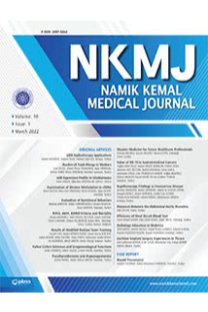GİZLİ VE GÜVENLİ; YER ALTI HASTANELERİ
HIDDEN AND SAFE; UNDERGROUND HOSPITALS
___
- 1. Özkul AE: Sağlık sistemleri planlama ve kontrolü . A.Ü. Yayın No: 819: A.Ö.F. Yayın No: 429, 1994; Eskişehir. 2. World Health Organization: Hospitals [İnternet yayını]. [atıf 14.03.2019] Erişim:https://www.who.int/hospitals/hospitals-in-the-health-system/en/ 3. World Health Organization: Safe hospitals in emergencies and disasters: structural, non-structural and functional ındicators. WHO Library Cataloguing in Publication Data [İnternet yayını]. 2010 [atıf16.01.2019]Erişim:http://www.wpro.who.int/emergencies_disasters /documents/SafeHospitalsinEmergenciesandDisastersweboptimized.pdf 4. Banatin CA, Go MV, PeňafielRM,Bituin RA (Eds). Safe hospitals in emergencies and disasters: Philippine ındicators. Protect hospitals and health facilities in emergencies and disasters. 2nd ed. Department of Health, Republic of the Philippines [İnternetyayını]. 2009 [atıf 25.03.2019] Erişim: https://home.doh.gov.ph/uploads/downloads/ DOH_INTRANET_safehospitalsinemergenciesphilippi neindicators_225104.pdf 5. Roberts DV. Sustainable development and the use of underground space. Tunnelling and Underground Space Technology.1996; 11 (4) 383-390. Erişim: https://doi.org/10.1016/S0886-7798(96)00039-9 6. Fallon K, Kieval N. Saving lives underground the case for underground hospitals in Syria. (Rapor 1.0) The Syria Campaign [İnternet yayını]. 2017 [atıf25.03.2019].Erişim: https://savinglivesunderground.thesyriacampaign.org/ 7. Tombaccini D, Lippi D, Lelli F, Rossi C. Florence and ıts hospital a history of healthcare and assistance ın the florentine area: Firenze University Press, 2008; 126-129. 8. Thomas G: Quand le servıce de santé faısaıt « carrıères » la réutilisation des creutes de l’aisne pour l’activité du service de santé, pendant le premier conflit mondial . Médecıne Et Armées [İnternet yayını]. 2009,37,3 [atıf 15.03.2019].Erişim:http://www.annales.org/archives/x/creutes-de-aisne.pdf 9. Fairclough A. The German Underground Hospital in Jersey. Museum International.1993; 45(1):42-44. 10. Macpherson G, Beecham L. Wartime practice and modern medicine in Jersey Spring. Br Med J (Clin Res Ed) . 1988; 14 Mayıs; 296 (6633):1386-1388. 11. Queensland Goverment. Former underground hospital, Mount Isa [İnternet yayını] . [ atıf 14.03.2019] Erişim: https://apps.des.qld.gov.au/heritage-register/detail/?id=601102 12. Hospital in The Rock. The history of the hospital in the rock [İnternet yayını] . [ atıf 14.03.2019] Erişim:http://glomdhistoria.se/project/det-underjordiska-sjukhuset/ 13. Ghaleba S, Mukwege, Roberts R, Sulkowicz KJ, Vlassove V. Protect Syria's doctors: an open letter to world leaders. The Lancet. 2016;3888(10049):1056. 14. World Health Organization: Syrian Arab Republic Annual Report 2016 [İnternet yayını] . [ atıf 11.03.2019] Erişim: https://www.who.int/hac/crises/syr/sitreps/syria_annual -report-2016.pdf?ua=1 15. Physicians For Human Rights: The Syrian conflict: eight years of devastation and destruction of the health system [İnternet yayını] . [ atıf 15.03.2019] Erişim: https://phr.org/resources/the-syrian-conflict-eight- years-of-devastation-and-destruction-of-the-health- system/ 16. Attar S. The hell of Syria’s field hospitals. N Engl J Med. 2016; 374(23):2205-2207. 17. Glömd Historia: Civilförsvar det underjordiska sjukhuset [İnternet yayını] . 2016 Mart [atıf 10.02.2019] Erişim:http://glomdhistoria.se/project/det-underjordiska-sjukhuset/ 18. Tel-Avıv Sourasky Medıcal Center: About Tel Aviv Sourasky Medical Center [atıf 11.02.2019] Erişim: https://www.tasmc.org.il/sites/en/About/Pages/About.aspx 19. Sharon A. flexible building design offers future- proofing. IFHE Dıgest. 2012;96–98. 20. Pilosof NP, Kalay YE. Open building in practice: a comparative study of hospital design strategies for future change. Open Building For Resilient Cities Los Angeles, California / December 6-8, 2018(v2). 21. Shaare Zedek Medical Center: About Shaare Zedek [atıf 06.03.2019] Erişim:https://www.szmc.org.il/eng/About-Us/ 22. Hadassah Medical Center: Davidson Hospital Tower [atıf 06.03.2019] Erişim: http://www.hadassah- med.com/about/davidson-hospital-tower.aspx 23. Bar-El Y, Reisner S, Beyar R. Moral dilemmas faced by hospitals in time of war: the Rambam Medical Center during the Second Lebanon War. Med Health Care and Philos. 2014; 17(1):155–60 doi: 10.1007/s11019-013-9517-x 24. Bar-El Y, Michaelson M, Hyames G, Skorecki K, Reisner S, Beyar R. An academic medical center under prolonged rocket attack—organizational, medical, and financial considerations. Academic Medicine. 2009; 84(9): 1203–1210. 25. Design Build-Network: Rambam Health Care Campus Underground Hospital [İnternet yayını] . [ atıf 16.01.2019] .Erişim: https://www.designbuild- network.com /projects/rambamhealthcarecamp/ 26. Klein L, Michaelson M, Hyams G. Nato advanced research workshop: hospıtals under fıre - plannıng and operatıng a hospıtal under fıre and extreme cırcumstances. Mil. Med. Sci. Lett 2015;84(2):82-92. 27. Karakoç MN: Afet ve savaşlarda bir model olarak yer altı hastane sistemleri. 1st Disaster and Pre-Hospital Management in the Middle East Congress Book, 08 – 11 Kasım 2017,İstanbul. 28. Rambam Health Care Campus: Sammy Ofer fortified underground emergency hospital [atıf 06.03.2019] Erişim: https://www.rambam.org.il/en/?catid=%7Be0582f38-28eb-44d9-b4f1-521e134d6989%7D 29. World Health Organization. Attacks on health care dashboard Reporting period: 1 January - 31 December 2018 [İnternet yayını ] . 2019 [atıf 12 Mart 2019] . Erişim: https://www.who.int/emergencies/attacks-on-health-care/attacks-dashboard-2018-full.pdf?ua=1 30. Hebrang A, Henigsberg N, Golem AZ, Vidjak V, Brnić Z, Hrabac P. Care of military and civilian casualties during the war in Croatia. Acta Medica Croatica.2006; 60: 301–307. 31. Weisskopf V. The Jewish Hospital in Budapest under the Nazi occupation (1944-1945). Harefuah. 2008;147(1):81-4. 32. Tarrant JM. Moorfields eye hospital in the Blitz. British Journal of Ophthalmology. 1943; 27:312–319. 33. Eisenman A. Emergency care under fire and underground: a personal narrative. Isr J Emerg Med.2006; 6 (4):5-9.
- ISSN: 2587-0262
- Yayın Aralığı: 4
- Başlangıç: 2013
- Yayıncı: Galenos Yayınevi
Cigdem PULATOGLU, Derya BAŞBUĞ, Bertan AKAR, Hayal ŞİMŞEK, Pınar ÇAKIR, ALPER BAŞBUĞ, Eray ÇALIŞKAN
BÖBREK BİYOPSİLERİNDE AKUT İNTERSTİSYEL NEFRİT ORANLARININ DEĞERLENDİRİLDİĞİ (TEK MERKEZ ÇALIŞMASI)
THE SCHOOL MILK PROJECT CONDUCTED IN PRIMARY SCHOOLS AND PARENTS’ POINT OF VIEWS ON THE ISSUE
Sinan TÜFEKCİ, Bilge Sertel TÜFEKCİ, BİROL TOPÇU
EDİRNE İLİNDE TEDAVİYE DİRENÇLİ KRONİK OTİTTE KÜLTÜR ANTİBİYOGRAM SONUÇLARI
YASİN EMRE KAYA, Hande AKALAN, İbrahim YILMAZ, NUMAN KARAARSLAN, DUYGU YAŞAR ŞİRİN, HANEFİ ÖZBEK, Özkan ATEŞ
AYHAN ŞAHİN, İLKER YILDIRIM, Onur BARAN, Mustafa GÜNKAYA, Cavidan ARAR, Ercan GÜNERİ
Cem MİRİLİ, SEMRA PAYDAŞ, Mahmut BÜYÜKŞİMŞEK, Mert TOHUMCUOĞLU, Abdullah Evren YETİŞİR, Ali OĞUL
DERMATOLOGICAL ASPECT OF LABIAL FUSION: A PROSPECTIVE STUDY
GAMZE ERFAN, GAMZE VAROL, EBRU YEŞİLDAĞ
Alper BAŞBUĞ, Eray ÇALIŞKAN, Çiğdem PULATOĞLU, Derya BAŞBUĞ, Pınar ÇAKIR, Bertan AKAR, Hayal Şimşek
PROSTAT KANSERİ MOLEKÜLER MEKANİZMASINDA KODLANMAYAN RNA’LARIN ROLÜ
